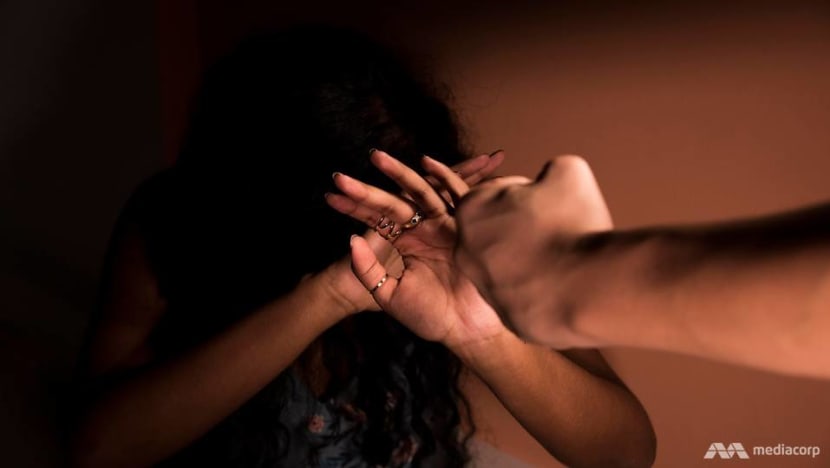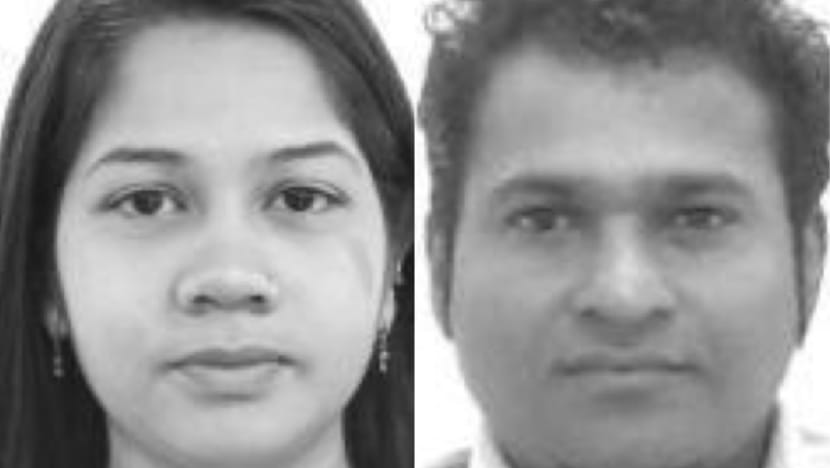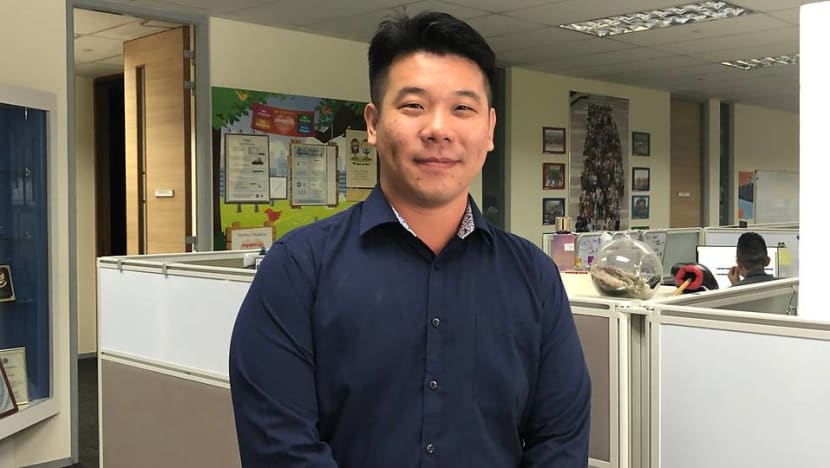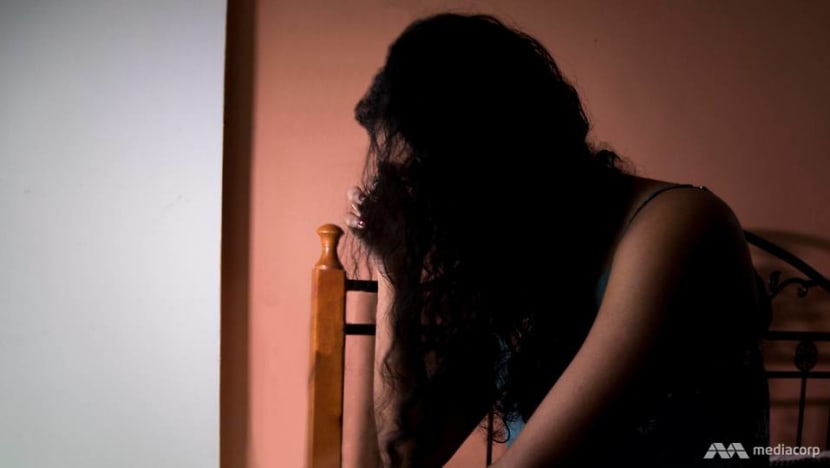‘She had lost all reason to live’: Undoing the horrors of being trafficked to Singapore and seeking justice
Two Indian nationals were the first in Singapore to be sentenced for labour trafficking. But to build a strong case against them, their victims had to come forward and share their ordeal, reliving the horrors of being abused.

File photo of man threatening a woman. (Photo: Try Sutrisno Foo)
SINGAPORE: Shanti* came to Singapore from Bangladesh thinking she was going to be a dancer at a Bollywood-style nightclub. The people she trusted the most abused her, stripped her freedom and forced her to “sell (her) vagina and earn money”.
She was among three Bangladeshi women who were trafficked into Singapore.
Indian nationals Priyanka Batthacharya Rajesh and Malkar Savlaram Anant were each sentenced to five years and six months jail and a S$7,500 fine on Tuesday (Feb 11) after they were found guilty of labour trafficking under the Prevention of Human Trafficking Act. They were the first such convictions under the legislation, which was enacted five years ago.

Building a case against Priyanka and Malkar was challenging.
To prove someone has been trafficked, three aspects need to be covered – the act of recruitment, the means that might involve deception and it was done for the purpose of exploitation.
“Generally, proving the purpose is challenging for labour trafficking cases,” Shirley Lim, co-chair of the Singapore Inter-Agency Taskforce on Trafficking in Persons said. The taskforce, formed in 2010, is co-chaired by the Ministry of Home Affairs (MHA) and the Ministry of Manpower (MOM), and consists of nine agencies.
“We have to prove elements of the exploitation here. We have to say how was this person coerced and duped into performing certain acts, and that it is not something that they did willingly.
“Some of the things defence lawyers may use is to say that (the victims) could have escaped. Maybe (if) they did not escape, it means that they are not victims,” she explained.

Two challenges Ms Lim has identified when it comes to tackling cases of human trafficking are establishing culpability and relying on victim testimonies.
“One of the challenges is that (these cases) are very victim centric. A lot of it depends on the victims’ testimonies so we require the victims to be willing to come forward.
“The more coherent their testimonies are, the stronger our cases will be.
“Some of them could be quite traumatised and some of them just want to return home. Because they have been traumatised … they may have a mistrust in authorities.
“Our investigators have to work quite hard to earn their trust so they get the right testimonies they can use for the case.”
LEARNING TO TRUST PEOPLE AGAIN
The challenge of gaining the trust of someone who has been deceived, exploited and abused by people they placed their faith in is something that all those involved in this case had to face.
The three women were subjected to oppressive conditions by Priyanka and Malkar – the last people they thought would harm them.
The women were promised jobs as dancers at two Bollywood clubs – Kanggan and Kickk.
READ: Sex trafficking in Singapore: How changes to the law may protect women duped into prostitution
The couple instead illegally harboured the women – locking them up at home and confiscating their passports.
If they complained customers violated them, the women were reprimanded. When they were sick, they had to work - sometimes seven days a week.
Against her will, Shanti had to provide sexual services to customers, and when she tried to return to Bangladesh, she was threatened with financial penalties.
“So imagine they trusted the person - this deceiver had a close relationship with the victim - and then this was broken,” said Fu Mingfeng, senior investigative officer from MOM.
“The person went through long periods of exploitation and is now passed over to this NGO and this group of people saying, ‘Look I’m here to help you.’
“It’s hard for them. People who have suffered the trauma from trafficking, slavery and abuse - it takes time for them to be able to invest in trusting relationships.
“We cannot expect them to trust us fully just because we have all the good intentions to help them because of what they have suffered ... You really have to let them see you have actions instead of just words.”

He gave the women his phone number so they had a trusted contact to reach out to at all times. He stayed by their side for more than two years, accompanying them to court hearings.
It was the little things that helped build the trust, he said, as he shared about one woman who called him at 10pm for a ride home because she had lost her wallet.
“They will call me up and start telling me about their problems. Maybe they want a new job or they have problems with their current jobs and they aren’t happy,” Mr Fu shared.
This was part of a “victim-centric” investigation process that moved away from enforcement to caring for and empathising with their situation.
Building rapport with the women was pivotal in their case because it was only when they opened up about the abuse that a concrete case could be developed to bring Priyanka and Malkar to trial and secure a conviction.
Using the evidence that the authorities gathered – photos, log books, passports, phones and CCTV footage – and the consistent accounts from each woman, the investigation team pushed for prosecution.
READ: Sex work in Singapore: Will changes to the Women’s Charter be enough to tackle exploitation?
The language barrier also proved to be an issue as the women were not fluent in English when they were first rescued. At the start of the process, interpreters had to be called in to help with translation.
“When you ask them a question they will only answer you with one word – yes or no – because language was a problem,” Mr Fu admitted.
As the building of the case continued, tackling the emotional trauma the women went through was crucial. Trafficking victims can sometimes find themselves caught up in a whirlwind of emotions during their road to recovery as they go through the cycle of grief.
“At the start they may be depressive, unmotivated and passive… (then) they become difficult,” said Lynette Lim, director of development and communications in Hagar, an NGO that deals with trauma recovery.
“I think that is when anger sets in … You think that the world owes you because it was so unfair.”
The women had come to Singapore hoping for a better life, but by the time they were rescued and referred to Hagar, one of them, Puja*, had suicidal thoughts.
“She kept saying she has no reason to live anymore and that she wants to die. She felt as if she had lost all reason to live,” said Ms Lim.

Growing up in Bangladesh, the women were seen as second class citizens and not as important as men.
“Sometimes when they are abused, they accept that this is their fate. Because they are women. And they don’t think about of themselves as a person of value,” Ms Lim said.
The women built such strong defences to protect themselves that counsellors had to work out a way to break them down.
“They may reject you, they may seem ungrateful for all the things you have done, but just continue doing it because this is the right thing to do,” Ms Lim explained.
“That’s their way of coping.”
“WHERE’S THE MONEY?”
But even as they heal their emotional wounds and those who trafficked them brought to justice, a new set of problems has emerged.
“’Look, you’ve been in Singapore for so long – where’s all the money?’ their families would ask them,” Mr Fu said.
Ms Lim added: “They came to Singapore finding work because they were pressured by financial concerns. They have to feed their children back home or their parents."
Being rescued means they no longer have a source of income. "When they had (money), they were exploited and abused, but for some of them at least they still are able to generate money to send back home,” she said, explaining that helping the women find job opportunities was an important step.
“When you are able to work with your hands, and you see that what you do produces income that you can use to support your family, that helps to restore the dignity and self-worth.”
Ensuring the women became independent was a challenging task and a race against time as the necessary support – emotional, educational or financial – had to be done within the few years the women were in Singapore.
Despite all the hurdles during investigations, Priyanka and Malkar were successfully convicted and sentenced.
READ: Married couple who ran Boat Quay nightclubs found guilty in Singapore's first labour trafficking conviction
DARING TO DREAM AGAIN
This labour trafficking conviction is a “significant milestone”, Ms Lim said.
“We really hope that it sends a strong message to these criminals in this case who are eyeing to exploit vulnerable individuals.”
“To the (women), I really want to thank them for staying with us because, without them personally giving evidence in court, the case won’t be at this stage right now,” Mr Fu said.
“Most of the credit goes to them for the willingness to pour out - to give their accounts personally - and to revisit all these events.”
Although it was a challenging case, hope was a driving force.
“(The women) now dare to dream. In the past, they were not able to think about their future,” Ms Lim said. “Our setbacks in life do not have to determine our future.”
Two of the women have since found jobs in Bangladesh, and are hoping for overseas opportunities.
*Names have been changed to protect the women's identities.














